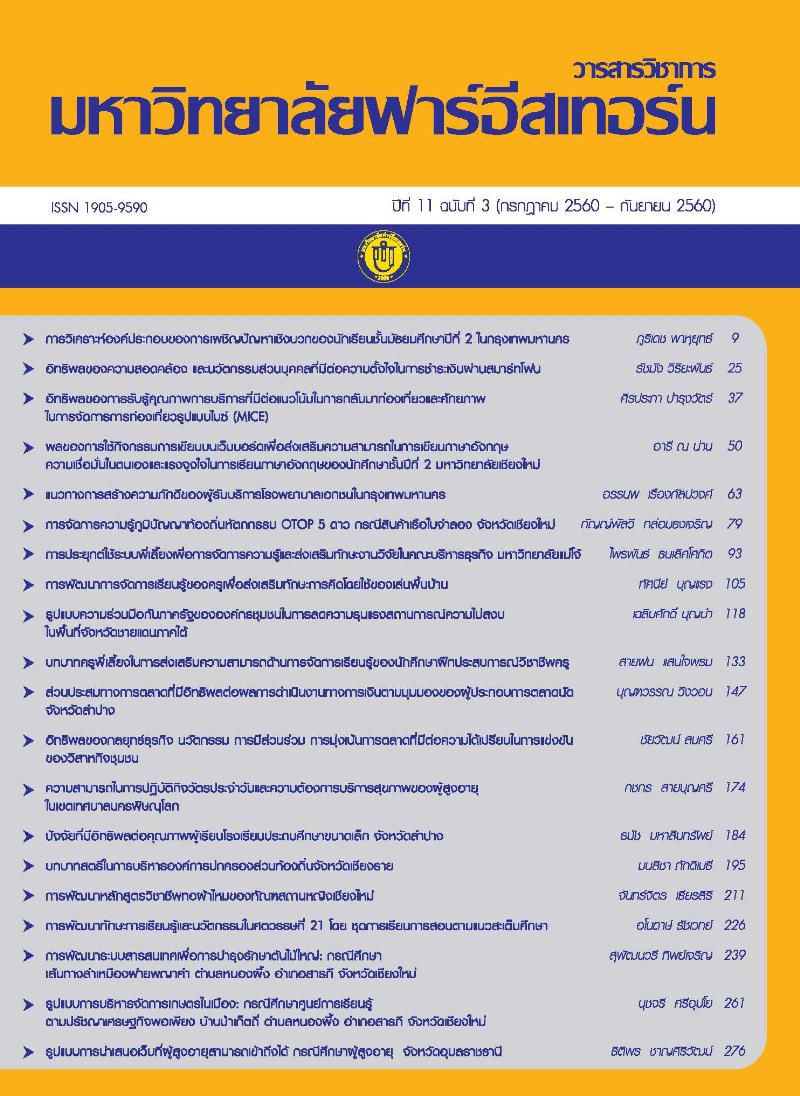ปัจจัยที่มีอิทธิพลต่อคุณภาพผู้เรียนโรงเรียนประถมศึกษาขนาดเล็ก จังหวัดลำปาง
Main Article Content
Abstract
งานวิจัยนี้มีวัตถุประสงค์เพื่อสร้างและตรวจสอบรูปแบบความสัมพันธ์โครงสร้างเชิงเส้นของปัจจัย
ที่มีอิทธิพลต่อคุณภาพผู้เรียนโรงเรียนประถมศึกษาขนาดเล็ก จังหวัดลำปาง กลุ่มตัวอย่าง ได้แก่ครู จำนวน
400 คน เครื่องมือที่ใช้ในการวิจัย คือ แบบสอบถาม วิเคราะห์ข้อมูลโดยใช้สถิติบรรยายความตรงเชิงโครงสร้าง
โดยโปรแกรมคอมพิวเตอร์
ผลการวิจัยสรุปได้ดังนี้ 1) ปัจจัยที่มีอิทธิพลต่อคุณภาพผู้เรียนโรงเรียนประถมศึกษาขนาดเล็ก
จงั หวัดลำปาง ไดแ้ ก (1) ปจั จัยดา้ นภาวะผนู้ าํ ผบู้ ริหาร ประกอบดว้ ย การกระตนุ้ ทางปญั ญา การคำนึงถึงความแตกตา่ ง
ระหว่างบุคคล การสร้างแรงบันดาลใจ และการมีอิทธิพลเชิงอุดมการณ์ (2) ปัจจัยด้านสภาพแวดล้อม
ประกอบด้วย สภาพแวดล้อมภายในโรงเรียน สภาพแวดล้อมภายนอกโรงเรียน และความสัมพันธ์กับชุมชน
(3) ปัจจัยด้านคุณภาพการสอน ประกอบด้วย พฤติกรรมการสอนของครู การร่วมมือและการแข่งขัน
ความสัมพันธ์ของครูและนักเรียน และการจัดรูปแบบชนั้ เรียน และ (4) ปจั จัยดา้ นคุณภาพผูเ้ รียน ประกอบดว้ ย
ดี เก่ง และมีสุข 2) ปัจจัยที่มีอิทธิพลต่อคุณภาพผู้เรียนมากที่สุด คือ ปัจจัยด้านภาวะผู้นำผู้บริหาร และปัจจัย
ที่มีอิทธิพลต่อคุณภาพผู้เรียนน้อยที่สุด คือด้านสภาพแวดล้อม 3) ผลการตรวจสอบความตรงของรูปแบบ
ความสัมพันธ์เชิงสาเหตุของภาวะผู้นำผู้บริหารที่มีอิทธิพลต่อคุณภาพผู้เรียนโรงเรียนประถมศึกษาขนาดเล็ก
จังหวัดลำปาง พบว่า โมเดลมีความสอดคล้องกลมกลืนกับข้อมูลเชิงประจักษ์ โดยไค-สแควร์ มีค่าเท่ากับ 52.33
ที่องศาอิสระค่า df = 45 (p = 0.21086) ซึ่งแตกต่างจากศูนย์อย่างไม่มีนัยสำคัญทางสถิติ ค่าดัชนีวัด
ความกลมกลืน (GFI) มีค่าเท่ากับ 0.98 ค่าดัชนีวัดความกลมกลืนที่ปรับแก้แล้ว (AGFI) มีค่าเท่ากับ 0.95 และ
ค่ารากกำลังสองเฉลี่ยของค่าความคลาดเคลื่อนในการประมาณ (RMSEA) มีค่าเท่ากับ 0.021
The objective of this research was to develop and investigate a linear structural relationship
model of factors affecting learner quality in small-sized primary school in Lampang province.
The sample of this study consisted of 400 teachers. The research instrument was the questionnaire.
Data were analyzed through descriptive statistics and construct validity via computer software.
The results of this research showed as follows: 1) the factors influencing the learner quality in
primary school included (1) executive leadership: intellectual stimulation, individualized consideration,
inspirational motivation, and idealized influence, (2) environment: internal environment, external
environment, and interaction with community, (3) instruction quality: instructional behavior of
teacher, cooperation and competitiveness, relationship between teacher and students, and classroom
management, (4) learner quality: Goodness, Intellect, and Happiness. 2) factors that influence the
quality of the students most is the leadership, management. And the factors that influence the quality
of the learning environment is minimal. 3) the results of validity of casual relationship model of
executive leadership influencing learner quality in small-sized primary school in Lampang province
showed that: the model was consistent to empirical information with chi - square of 52.33 at 45
degrees of freedom (df) (p = 0.21086), which was statistically significantly different from zero.
Goodness of Fit Index (GFI) was 0.98, Adjusted Goodness of Fit Index (AGFI) was 0.95 and Root
Mean Square Error of Approximation (RMSEA) was 0.021.
Article Details
1. Any views and comments in the Journal of Social Innovation and Lifelong Learning are the authors’ views. The editorial staff have not to agree with those views and it is not considered as the editorial’s responsibility.
2. The responsibility of content and draft check of each article belongs to each author. In case, there is any lawsuit about copyright infringement. It is considered as the authors’ sole responsibility.
3. The article copyright belonging to the authors and The Far Eastern University are copyrighted legally. Republication must be received direct permission from the authors and The Far Eastern University in written form.
References
เอกสารอ้างอิง
สำนักทดสอบทางการศึกษาสำนักงานคณะกรรมการการศึกษาขั้นพื้นฐาน. (2556). รายงาน
ลักษณะที่พึงประสงค์ของผู้เรียน.กรุงเทพมหานคร. สำนักวิชาการและมาตรฐานการศึกษา.
สำนักงานคณะกรรมการการศึกษาขั้นพื้นฐาน. (2552). หลักสูตรการศึกษาขั้นพื้นฐาน.
กระทรวงศึกษาธิการ.ลำปาง: ลำปางพริ้นติ้ง.
อินทุอร โคว้งชัย. (2554). ความสัมพันธ์ระหว่างภาวะผู้นำการเปลี่ยนแปลงกับคุณภาพการ
บริหารงานวิชาการโรงเรียนสังกัดสำนักงานเขตพื้นที่การศึกษาประถมศึกษาขอนแก่นเขต
วิทยานิพนธ์ ศึกษาศาสตรมหาบัณฑิต คณะศึกษาศาสตร์ มหาวิทยาลัยขอนแก่น.
Bass , B. M. (1994). The Ful Range Leadership Development Programs: Basic
And Advance Manual. New York : Binghamton.
Hair, J. F., (2006). Multivariate date analysis. New Jerssey : Pearson Education.
Goddard , R. D. (2000). Collective teacher efficacy: Its meaning, measure, and
effect on student achievement. American Education Research Journal.
Nicholson M.R. (2003). TRANSFORMATIONAL LEADERSHIP AND COLLECTIVE
EFFICACY:A MODEL OF SCHOOL ACHIEVEMENT. The Ohio State University
Russell, C. A. (2000). Community college academic deans: Leadership frames and stress.
Dissertation Abstracts International, (CD-ROM), 9990484.
Stogdill. A.B. (1974).A Survey of Theory and Research . June 1974.p 307-418.

